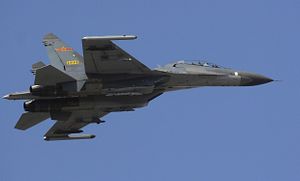A few mid-week defense and security links:
Writing in Popular Science, Peter W. Singer and Jeffrey Lin outline China’s self-installed upgrades on its Shenyang J-11D flanker fighters. The J-11D is a Chinese-licensed and modified version of Russia’s Sukhoi Su-27 Flanker, a single-seat, twin-engine fighter, intended for an air superiority role. The authors highlight the aircraft’s upgrade, which are visible in new imagery and videos. The J-11D features “an upwardly canted radar dome, which carries an Active Electronically Scanned Array (AESA) radar,” stealth improvements on the fuselage to reduce weight and radar signatures, a relocated Infrared Search and Tracking (IRST) pod, and is “believed to have improved weapons hardpoints to carry the latest Chinese weapons, such as the PL-10 air to air missile, long range PL-21 missile and YJ-12 antiship missile.”
In case you missed it, the Stimson Center recently released a new report, “Deterrence Instability & Nuclear Weapons in South Asia,” which discusses the state of nuclear deterrence in South Asia, one of the world’s likeliest nuclear flashpoints. The report includes a discussion of India’s nuclear doctrine, a comparative exploration of strategic culture in India in Pakistan, and new military technologies that could shift the nuclear balance of power in the region. Michael Krepon, one of the editors of the report, discusses its findings in an accessible blog post over at Arms Control Wonk.
Speaking of technologies and nuclear balance in South Asia, a report in the Indian Express examines India’s troubled ballistic missile defense development program. In theory, India’s BMD development would guarantee a “shield” over India’s major cities, including New Delhi, but as Sushant Singh details in his piece, there are major shortcomings and delays. India’s Defense Research and Development Organization (DRDO) had suggested that initial systems would have been deployed by 2013. Yet, in 2015, the program continues to fail tests.
History remains alive and well in East Asia: South Korea’s government will distribute a report in Japan on the Koreans who were killed in the atomic bombings of Hiroshima and Nagasaki at the end of the Second World War. The report comes at a time of high tensions between South Korea and Japan, and as the region marks the 70th anniversary of the end of the war. Meanwhile, Japan noted on Monday that it had received an endorsement from UNESCO for “the listing of major wartime industrial facilities as World Heritage sites.” At least seven of these facilities were sites of Korean slavery under Japanese colonial rule, and the possibility of their commemorating as World Heritage sites has drawn sharp criticism from South Korea.
































